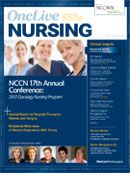Genetic Assessment of Breast and Ovarian Cancer Risk
Understanding the genetic basis of breast and ovarian cancers is essential to providing patients with effective preventive and/or management strategies that can improve outcomes.
Heather Hampel, MS, CGC
With the advent of more targeted approaches to cancer treatment, understanding the genetic basis of breast and ovarian cancers is essential to providing patients with effective preventive and/or management strategies that can improve outcomes. Heather Hampel, MS, CGC, a professor and certified genetic counselor at The Ohio State University Comprehensive Cancer Center in Columbus, discussed the genetic basis for breast and ovarian cancer at the NCCN annual meeting.
The causes of hereditary susceptibility to gynecologic cancers include hereditary breast-ovarian cancer syndrome, Lynch syndrome (endometrial and ovarian cancer), Cowden syndrome (endometrial and breast cancer), and Li-Fraumeni syndrome (breast cancer).
Approximately 5% of breast cancers are hereditary and 15% to 20% occur in family clusters, while 10% to 15% of ovarian cancers are hereditary. Heredity breast or ovarian cancer tends to occur at an earlier age and involves multiple generations with cancer or clustering of certain cancers, while sporadic cancer is likely to occur at a later age and occurs as a single or unilateral tumor and is associated with limited family history of cancer.
Genetic mutations in BRCA1 and BRCA2 account for the vast majority of hereditary breast-ovarian cancer syndrome. BRCA1 mutations increase the risk of primary breast cancer, second primary breast cancer, ovarian cancer, and prostate cancer in men. BRCA2 mutations also increase the risk of breast and ovarian cancer in women, and increase the risk of male breast cancer, as well. In addition, BRCA2 mutations may be associated with an elevated risk of prostate, laryngeal, and pancreatic cancers. Triple-negative breast cancers are more likely due to BRCA1 mutations and women aged <60 years with triple-negative breast cancer should be tested, regardless of family history.
While all of the risk factors for BRCA1- and BRCA2-positive cancers are not well understood, individuals of Ashkenazi Jewish descent are ten times more likely to have these mutations than the general public. One in 40 Ashkenazi Jews, both male and female, carries a BRCA1 or BRCA2 mutation, while one in 400 carries the mutation in non-Jewish populations.
The cost of genetic testing for breast and ovarian cancer risk depends on the extensiveness of testing. For comprehensive testing involving both BRCA1 and BRCA2 analysis, the cost is approximately $3340; however, most insurance companies will provide coverage if the patient’s need for testing is demonstrated. Follow-up large rearrangement testing is approximately $700 and is not always covered by insurance because the risk of a major rearrangement is rare. Other types of genetic testing include singlesite analysis that costs approximately $475 and evaluates a specific gene that may be found within a family, and Multisite 3 that costs about $575 and looks at three specific mutations commonly found in Ashkenazi Jews.
According to Hampel, the clinical management of BRCA-positive cancer patients includes increased surveillance, lifestyle changes, chemoprevention, and prophylactic surgery. Surveillance for BRCA mutation carriers includes monthly breast self-exams starting at age 18, clinical breast examinations every 6 months starting at age 25, and annual mammography and breast magnetic resonance imaging starting at age 25. Surveillance will also involve ultrasound with color Doppler imaging every 6 to 12 months, starting at 30 to 35 years of age.
In some BRCA-positive patients, especially in patients with BRCA2 mutations, chemoprevention with tamoxifen may be prescribed. Oral contraceptives may also be used to prevent the risk of ovarian cancer. In the general population, oral contraceptives reduced the risk of ovarian cancer by 40% to 50% after 3 years of cumulative use. However, the benefits and risks of oral contraceptives for chemoprevention and contraception need to be weighed.
One popular option for the prevention of breast cancer is prophylactic mastectomy, which removes most, but not all, breast tissue. The approach has been shown to reduce the risk of breast cancer by 90% to 95%. Another approach is prophylactic oophorectomy, which decreases the risk of ovarian cancer by 85% to 90%. It is crucial that patients are fully informed of the latest clinical information before selecting either of these options.
Beyond prevention strategies, BRCA1 and BRCA2 testing might also help guide treatment. Currently, Poly-ADP ribose polymerase (PARP) inhibitors are being studied for the treatment of BRCA-positive breast and ovarian cancers. “PARP inhibitors have the potential to enhance cytotoxicity of cancer treatment and reverse tumor cell resistance,” Hampel said.



